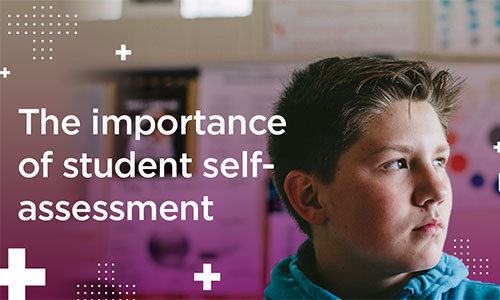
Using assessment data to differentiate instruction can seem like a daunting task. My initial resistance to data originated from a hesitance to disrupt the flow of my classroom; appearing as intentional “chaos,” my lessons were chock-full of academic discourse, dynamic collaboration, and purposefully planned activities. But as a New York City model teacher, not only was I expected to be using assessment data to differentiate instruction, but I was also expected to set an example for best practices.
As I revisited my educator mindset, I realized I had to overcome my own limiting disposition to data to see it as an essential tool. I was already homing in on students’ needs through informal observations and interactions—learning my students’ hearts and minds—and formative assessment data like exit tickets and quick, ungraded quizzes. But when I started actually understanding how to read my assessment data and put it to use when differentiating, I ensured that every student felt engaged at their instructional level while feeling seen and accommodated as an individual in their learning.
Once I learned how to make my data work for me, it not only informed my (very) dynamic classroom, but it also enhanced it.
Teachers, you’re already differentiating
In our classrooms, we have varying degrees of learner readiness, literacy level, numeracy skills, at-home supports, and interests. Being asked to differentiate instruction can sometimes feel like teachers are octopuses with way more than eight tentacles. Teachers have limited time to make bespoke versions of an assignment for each student—and, sometimes, attempts to differentiate for students who need more support can feel like we’re perpetuating limiting labels. But once we remember that we’re already differentiating, every time we speak to an individual student, it all becomes much, much simpler.
We begin differentiating the moment we meet our students and hopefully continue to expand our practice the more we get to know them. When introducing a new project, for example, we know one student should be offered an option to create a video because he’s often expressed an interest in gaming culture, while another would benefit from an essay alternative as she enjoys writing. Using assessment data to differentiate instruction simply adds another instructional layer onto what we’re already doing at the personal level. When we use this ongoing data as a snapshot to certify that a learner is where we thought—and not somewhere we simply assumed!—we can then make ongoing choices to support that learning.
We begin differentiating the moment we meet our students and hopefully continue to expand our practice the more we get to know them.
Differentiation isn’t a singular action; it’s a multifaceted, ongoing best practice—and likely one that you’re already doing as you interact with each student. Bringing assessment data into the conversation doesn’t have to create more work. It will simply formalize what you’re already sensing: the growth at the intersection of your students and your content. Read on for three strategies for using assessment data to differentiate instruction.
Tip #1: Keep in mind that differentiation is at the intersection of data, learner context, and content
Responsive planning takes multiple sources into account: formative assessment’s ongoing temperature checks of a student’s grasp on the material; interim and summative standardized data reports; and, just as importantly, the relationship between teacher and student.
When differentiating, I would not only take into consideration my students’ formative assessment results, but I would pay great attention to their strengths, interests, social preferences, and dynamic personalities. Data (the stats specifically) helps to certify the learning, illuminating when progress objectively is or isn’t made. Data makes growth and progress tangible. But just as essential is knowing your students’ learner context: who they are, how they prefer to communicate their thinking, and all the other things that make them an individual.
Tip #2: Start small with the Class Profile report
When it comes to using assessment data to differentiate instruction, there simply aren’t enough hours in the day. If you test with MAP® Growth™, I encourage you to use the Class Profile report. This is a perfect report to consult when dynamic student groups might be a better configuration than whole-group instruction.
Flexible grouping is an approachable, entry-level differentiation skill, and it can be done with the support of the data from the Class Profile report. It’s one of my favorite reports as its brilliance lies in its simplicity. If you are a teacher who feels overwhelmed and not sure where to begin your planned groupings, it is a super user-friendly report that you can put into action on Monday morning.
Tip #3: Grow your data literacy—with help
It is essential for teachers to develop their assessment literacy alongside their fluency in MAP Growth metrics to really get the most out of their differentiation practice. To support teachers and school leaders, NWEA offers Responsive Teaching and Learning workshops that reinforce and develop assessment literacy best practices. A complimentary workshop is our “MAP Growth Basics,” which ensures teachers and leaders can not only speak to but also powerfully use all the fun stuff, such as RIT score, instructional levels, and our normative data to inform differentiation.
Professional learning should not be an individual endeavor. Identify a colleague who’s interested in using assessment data to differentiate instruction. Identify another colleague whose practice you already admire. Ask them to collaborate or coplan with you. Interdisciplinary visitations, spotlight classroom visits, and tangible tip trades are great ways to inspire the use of new strategies.
Keep learning
Using assessment data to differentiate instruction can seem like a steep hill to climb. I was once at its bottom and expected to lead others to the top. Once I revisited my fixed mindset, I was able to quickly harness my data and not only enhance my instruction, but also capitalize on what I was already doing well: seeing my students as individuals.
Curious about content-specific differentiation tips? Math teachers, check out my post on differentiation in the math classroom. Literacy teachers, read our post on scaffolding to close reading gaps.






